This is an automatically translated article.
Sarcoma is a rare cancer that most commonly occurs in the bones, muscles, tendons, cartilage, nerves, fat, and blood vessels of the arms and legs, but they can also occur in other areas on the body.
1. What is Sarcoma?
Sarcoma is a term used to refer to a type of cancer that is likely to occur in many parts of the body.
Sarcoma is a group of cancers that start in bone and soft tissues (also called connective tissue). Soft tissue sarcomas form in the tissues responsible for connecting, supporting, and protecting various body structures including the muscular system, blood vessels, nerves, tendons, and the lining of the joints.
Currently more than 70 types of sarcoma have been discovered. Treatment for these cancers can vary depending on the location of the tumor, age, gender, general health, and other factors.
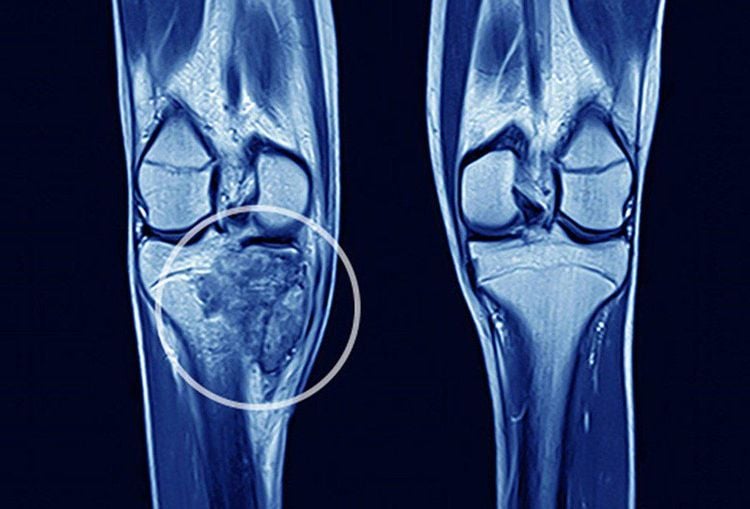
Hình ảnh bệnh sarcoma xương
2. Types of Sarcomas
Below is a list of some typical types of sarcoma.
2.1 Angiosarcoma
Angiosarcoma is a rare but relatively dangerous cancer that forms in the lining of the blood vessels and lymph nodes. Lymph nodes are part of the body's immune system that destroys bacteria, viruses, and other harmful agents. Angiosarcoma can occur in any part of the body, but most often form on the skin of the head, face, neck, or other areas that have received radiation therapy in the past.2.2 Chondrosarcoma
Chondrosarcoma is a rare cancer that starts in the bones or soft tissues near the bones, especially the pelvis, hips, and shoulder blades.
Surgical removal of the tumor is the main treatment while chemotherapy or radiation therapy is less indicated in the treatment of chondrosarcoma.
2.3. Dermatofibrosarcoma protuberans (DFSP)
DFSP is a very rare type of skin cancer that occurs in the connective tissue cells in the dermis of the skin. This type of cancer is usually slow growing and rarely spreads to other organs.
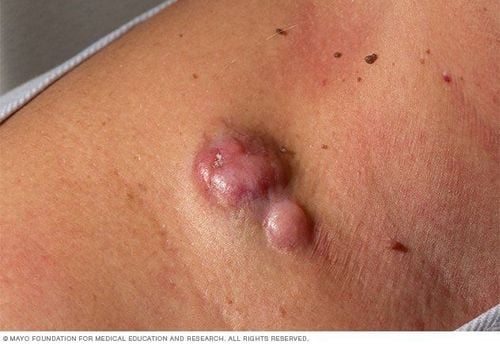
Hình ảnh của bệnh Dermatofibrosarcoma protuberans (DFSP)
2.4 Small cell cancer
Small cell cancer, also called desmoplastic, is a type of soft tissue cancer of the abdomen and rarely occurs in other organs. Desmoplastic occurs mainly in young men.
Desmoplastic tumors often form in large numbers in the abdominal peritoneum as well as the pelvis and quickly spread to other areas of the abdomen. Desmoplastic treatment often requires a combination of surgery, radiation, and chemotherapy.
2.5 Epithelioid sarcoma
This is a rare, slow-growing, epithelioid sarcoma that usually starts in the soft tissues under the skin of the fingers, hands, forearms or feet....
2.6 Ewing sarcoma
Ewing sarcoma is also a rare cancer that occurs in the bones or soft tissues around the bones, mainly the bones of the legs and pelvis. Ewing sarcoma mostly occurs in children and adolescents, causing limitations in height growth.
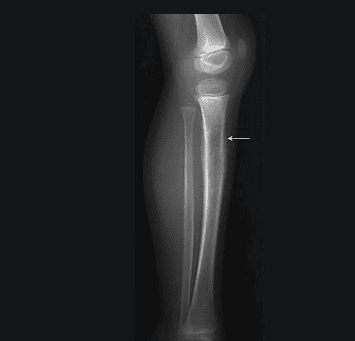
Ewing sarcoma là bệnh ung thư ở xương chân
2.7 Gastrointestinal connective tissue tumors (GISTs)
GISTs are tumors that occur in any connective tissue part of the digestive system, especially the stomach and small intestine.
GISTs originate from specialized nerve cells of the digestive system. GISTs are often silent and cause few symptoms in the early stages and often progress slowly. Diagnosis of GISTs can be based on some initial symptoms such as vomiting blood or bloody stools....
2.8 Leiomyosarcoma
Liposarcoma is a rare cancer that originates in smooth muscle cells. Tumors of leiomyosarcoma are usually large in size, more than 10 cm in diameter, accompanied by symptoms of pain, nausea or vomiting, weight loss...
2.9 Liposarcoma
Liposarcoma is a rare cancer that forms in the body's fatty tissues, mostly the muscles of the extremities and the subcutaneous fat layer of the abdomen, and is common in the elderly.Treatment of liposarcoma is based on 2 main methods: surgery and radiation therapy.
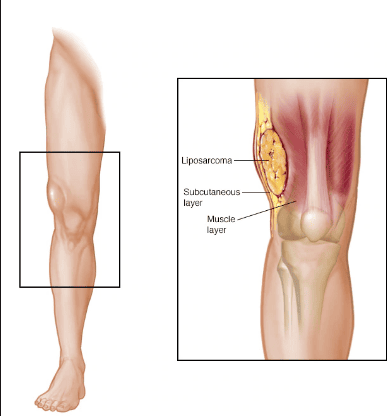
Liposarcoma là một loại ung thư hình thành trong các mô mỡ của cơ thể
2.10 Osteosarcoma
Osteosarcoma is a type of bone cancer found in long bones such as legs or arms. Some cases of osteosarcoma can originate in the connective tissue outside the bone. This type of cancer usually occurs in teenagers or children.3. Causes and Risk Factors of Sarcoma
In general, cancer in general and sarcoma in particular form when there are mutations occurring in the DNA genetic material of cells, leading to disorders in cell division that cause them to multiply uncontrollably.
Several factors increase the risk of sarcoma:
Genetics: Families with one parent with sarcoma are more likely to have children with one of these types of sarcoma. Radiation therapy for cancer: Other types of cancer treated with radiation may increase your risk of sarcoma later in life. Lymphedema: A risk factor for angiosarcoma. Chemical exposure: Some chemicals used in agriculture such as herbicides, pesticides, etc. can increase the risk of sarcoma Virus: A virus called human herpesvirus 8 is found in humans. demonstrated to significantly increase the risk of kaposi's sarcoma, especially in people with weakened immune systems.
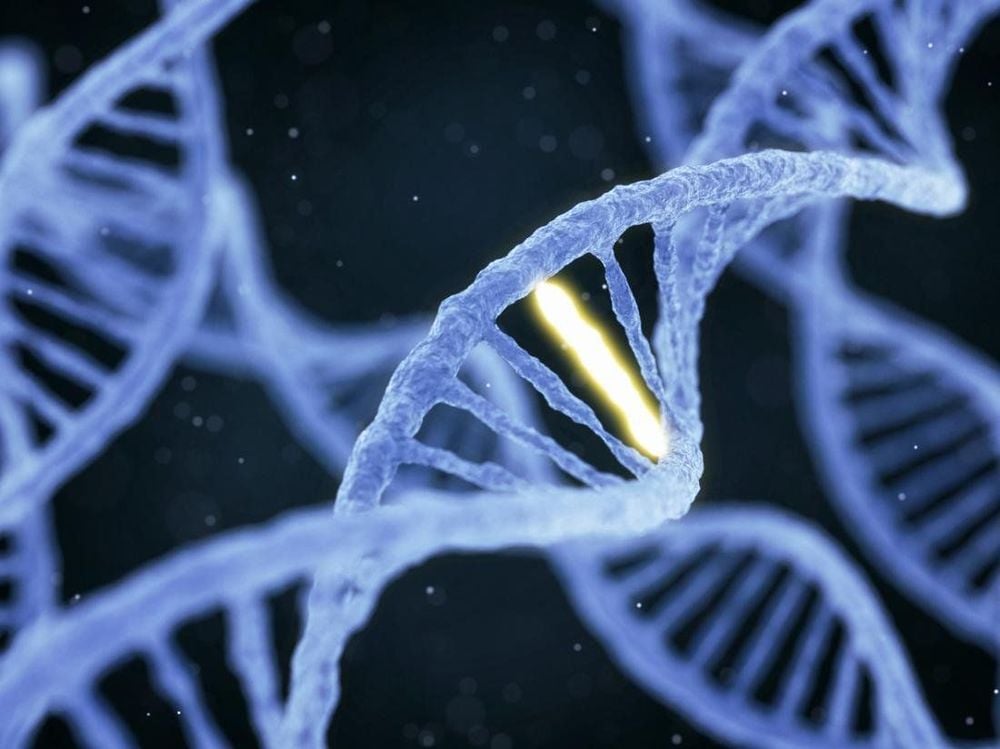
Di truyền là yếu tố tăng nguy cơ của Sarcoma
4. Symptoms and Diagnosis of Sarcoma
4.1 Symptoms
Some of the signs and symptoms of sarcoma include:
Physical examination reveals several tumors on the skin. Joint pain Abdominal pain Weight loss
4.2 Diagnosis of sarcoma
Tests and methods used in diagnosing sarcoma and determining the stage of the disease include:
Physical examination: To look for external signs of tumors. Imaging: Indications for imaging tests will depend on the type of sarcoma cancer. For example, X-ray or computed tomography would be used in the diagnosis of sarcomas involving the bone or ultrasound and magnetic resonance imaging to determine the existence of tumors in the connective tissue. . Biopsy: A biopsy is a technique to remove a tissue from a suspected tumor area to test and diagnose cancer. This is the most accurate method that can tell the type of cancer and its stage.
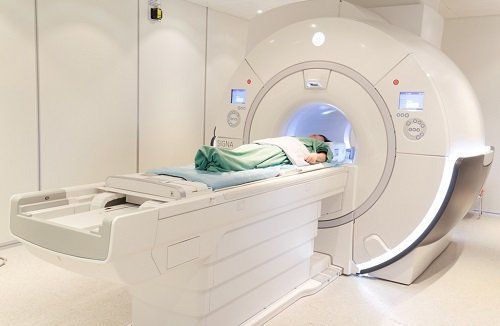
Chụp cộng hưởng từ cho phép chẩn đoán hình ảnh các khối u ở các mô liên kết.
5. Treatment of Sarcomas
The most commonly used sarcoma treatment is surgery to remove the tumor. Other treatments may be indicated before or after surgery and depend on the type of sarcoma, the location of the tumor, or how far the cancer cells have spread.
Methods used in the treatment of sarcoma include:
Surgery: The goal of surgery is to remove all cancer cells from the body, even removing part or all of an organ. contain cancer cells. In cases where the tumor is located in vital organs such as the liver, lungs, heart ... or near nerves, the surgical method will try to remove as much of the cancer cells as possible without causing damage. those agencies. Radiation therapy: Radiation therapy uses powerful beams of energy such as X-rays and protons to kill cancer cells. However, these rays also have the ability to destroy normal cells, so radiation therapy is usually only applied to a small area of the body. Chemotherapy: Chemotherapy is the use of chemicals to kill cancer cells. Immunotherapy: Immunotherapy uses drugs that stimulate the body's immune system to destroy tumors. Cancer cells make a protein that disables the body's immune system, and immunotherapy is used to block that process.
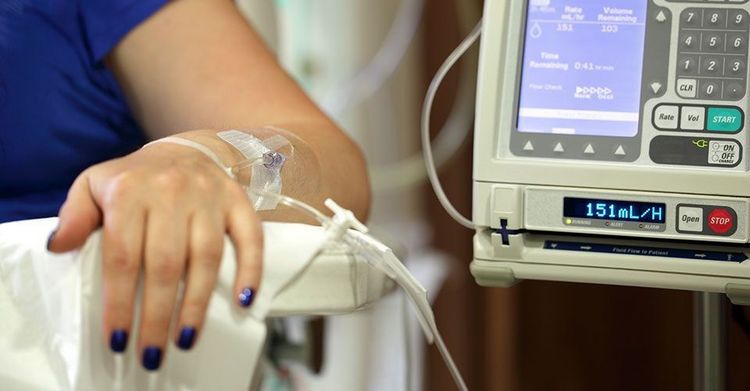
Hóa trị là một phương pháp điều trị Sarcoma
Early cancer screening is considered the "golden key" for early detection and effective cancer prevention and treatment regimens, thereby reducing the risk of death and reducing costs for people. sick. Currently, Vinmec has been and is a leading medical facility in the field of detection, the high-tech cancer screening package at Vinmec gives you the opportunity to screen and detect timely warning risks. to optimize treatment efficiency, improve quality of life.
For detailed information, please contact the hospitals and clinics of Vinmec health system nationwide.
Please dial HOTLINE for more information or register for an appointment HERE. Download MyVinmec app to make appointments faster and to manage your bookings easily.
Reference sources: parkwaycancercentre.com, webmd.com
SEE MORE
Soft tissue sarcoma: Diagnosis and treatment What is the difference between cancer cells and normal cells How is bone cancer diagnosed?













